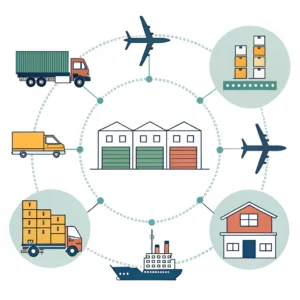By quickly ensuring secure payment practices and robust shipping company verification through Due Diligence1, contractual safeguards, and risk management measures, you can significantly reduce the likelihood of shipment delivery failure after payment clearance.
In today’s tightly interconnected international trade market, forwarders and import/export managers are often faced with critical concerns regarding shipment delivery assurances once payments have been fully cleared. Even though clearing payment can signal a step forward in the transaction process, it does not automatically guarantee that your shipment will be delivered as promised. This article introduces proven risk management strategies and best practices designed to help you confirm shipping company reliability and protect your interests throughout the shipping process.
Imagine completing all payment steps only to be left uncertain about whether the shipping company will deliver your goods on time—or even at all. This is a common concern in international logistics where factors like regulatory compliance, contract integrity, and communication issues may affect delivery outcomes. The risks can materialize in several ways:
• The shipping company could face operational delays or even insolvency after receiving payment.
• Unclear contractual terms can leave you vulnerable if the service provider does not fulfill the delivery commitments.
• Unforeseen external issues such as customs delays or procedural misunderstandings can exacerbate uncertainties.
These risks underline the need for a structured approach to ensure that payment clearance correlates with an on-time, successful delivery.
There are several reasons why shipment delivery might be at risk, even if payment is fully cleared:
- Lack of Proper Verification: In some cases, shippers may not have undergone extensive background checks to verify their reliability or financial stability.
- Inadequate Contractual Guarantees: Contracts without clearly outlined terms, penalties, and performance benchmarks increase the risk of non-delivery.
- Insufficient Payment Safeguards: Advanced payment methods may not include secure escrow or letter of credit arrangements that protect against non-performance.
- Poor Communication Channels: A breakdown in effective communication between the buyer and the shipping company can lead to misunderstandings and delays.
- External Risks: Issues such as customs delay, poor warehouse management, and political or economic instability in transit countries can impact delivery.
Addressing these root causes is essential in creating a robust risk mitigation plan for international shipments.
To ensure that the shipping company will deliver your shipment even after payment clearance, it is essential to combine industry best practices with contractual safeguards. Below is a detailed solution checklist that covers practical steps and methods to minimize risk:
-
Due Diligence and Background Checks:
- Conduct comprehensive research on the shipping company’s history, including past customer reviews and financial stability reports.
- Verify the company’s certifications, memberships, and regulatory compliances such as customs brokerage licenses.
-
Strong Contractual Agreements:
- Ensure that the contract explicitly states your delivery requirements, timelines, and the consequences in case of delays or non-delivery.
- Include detailed Service Level Agreements (SLAs)2 and penalty clauses for late or missed deliveries.
- Utilize dispute resolution clauses specifying arbitration or legal recourse.
-
Secure Payment Methods:
- Utilize Escrow Services3 or Letters of Credit4 for high-value shipments to protect your funds until confirmation of delivery is received.
- Coordinate with your bank or financial institution to establish payment procedures that include delivery triggers.
-
Regular Shipment Tracking and Communication:
- Implement robust tracking systems, and insist on real-time updates from the shipping company.
- Establish clear communication channels with dedicated points of contact to monitor progress and manage any arising issues.
-
Insurance Coverage:
- Insure high-value goods to minimize financial loss in cases where shipment delivery becomes problematic.
- Ensure your coverage policy includes transit risks and non-delivery claims.
-
Utilize Third-Party Logistics Providers (3PL)5:
- Partner with trusted 3PL providers who specialize in international shipping and have established risk mitigation strategies.
- Their expertise may provide additional layers of security and process transparency.
-
Performance History and References:
- Ask for references and case studies from the shipping company.
- Evaluate their past performance metrics, delivery times, and issue resolution strategies.
Below is a table summarizing the risk mitigation strategies, their benefits, and potential drawbacks:
| Strategy | Benefits | Potential Drawbacks |
|---|---|---|
| Due Diligence Checks | Enhanced understanding of the shipper’s reliability | Time-consuming, may require specialized resources |
| Strong Contractual Agreements | Legal protection with specific delivery and penalty clauses | Negotiations may be complex; variability in legal processes |
| Secure Payment Methods | Minimizes financial loss risk until delivery confirmation | May incur additional bank fees or require complex arrangements |
| Regular Shipment Tracking | Real-time monitoring of shipment progress | Requires compatible technology and reliable reporting channels |
| Insurance Coverage | Financial protection in case of shipment loss or damage | Additional cost factor |
| Third-Party Logistics Providers | Professional risk management and streamlined processes | May lead to higher service fees; integration complexity |
| Performance History Checks | Validates shipping company reliability | Dependent on the availability of transparent past data |
Different shipments and business situations may require one or a combination of these solutions. For instance, if you are about to ship a high-value load, using both escrow services and a robust tracking system would be highly effective combined measures.
Consider a multinational electronics importer who was concerned about shipment delivery after making an upfront payment. The importer implemented the following steps:
- Due Diligence: They verified that the shipping company had maintained a flawless delivery record for the past five years and had all relevant international certifications.
- Contractual Safeguards: They negotiated a detailed contract with clear delivery deadlines, including a penalty clause of a 5% rebate upon every day of delay.
- Escrow Payment: Instead of transferring all funds directly, the payment was made through an escrow account that only released funds upon confirmed delivery.
- Tracking and Communication: They utilized an advanced shipment tracking system that provided real-time updates and alerts in case of any deviations.
These steps not only built their confidence but significantly reduced the risk, and ultimately, the shipment was delivered without any delays. This example illustrates how combining multiple risk mitigation strategies can safeguard your interests.
-
Establish Clear Internal Protocols:
Create an internal checklist for vetting shipping companies and include verification steps such as business accreditation checks, reviews, and financial stability assessments. -
Develop a Standardized Contract Template:
Prepare a standardized contract template that includes SLAs, penalty clauses, and dispute resolution mechanisms. Customize it as per the value and complexity of each shipment. -
Integrate Secure Payment Processes:
Work with your financial team to set up payment processes that use approved payment channels, such as letters of credit or escrow services. This not only protects funds but also offers additional security for your transactions. -
Leverage Technology for Tracking:
Invest in shipment tracking software that integrates with your logistics operations. The technology should offer real-time visibility into every stage of the transit process.
-
Continuous Monitoring and Feedback:
Once you start shipping with a particular company, continuously monitor their performance and ask for regular feedback. Maintain a performance log to evaluate trends over time. -
Alternative Shipping Options:
Always have a backup plan by establishing relationships with multiple shipping companies. This diversification helps reduce dependency on a single provider and minimizes risks during unforeseen circumstances. -
Engage Legal and Insurance Experts:
Regularly consult with legal and insurance professionals to ensure that you are fully protected against potential delivery failures, thereby aligning contracts and insurance policies with industry best practices.
By rigorously following these implementation steps, your business can improve its shipping reliability while mitigating exposure to financial and operational risks associated with payment clearance.
Even after implementing the above strategies, it is vital to remain proactive in managing freight risks:
-
Regular Audits:
Periodically audit your shipping company’s performance and the effectiveness of the implemented risk management strategies. Audit results can provide insights into areas needing improvement. -
Market Dynamics:
Stay updated with global market trends and regulatory changes that might affect international shipping. This could include customs policies, global trade agreements, or even shifts in consumer demand related to shipping times. -
Stakeholder Training:
Ensure that all relevant personnel, from logistics managers to financial officers, receive regular training on current best practices in shipping risk management. Their collective expertise will contribute to more reliable and secure operations. -
Crisis Management Plans:
Develop a comprehensive crisis management plan that outlines steps to be taken in the event of shipment delays or non-delivery. Such a plan should detail communication strategies, refund procedures, and legal actions if necessary.
While making full payment to a shipping company can feel like a milestone, it is only one aspect of a larger process where ensuring shipment delivery is paramount. By performing due diligence, negotiating robust contracts, adopting secure payment methods, and maintaining active oversight throughout the shipping process, you can significantly reduce risk. These measures not only protect your financial interests but also provide peace of mind, bolstering long-term business confidence in global trade.
As a logistics professional, your next step should be to review your current shipping processes and identify areas where additional safeguards can be applied. Implementing a comprehensive risk management strategy, as discussed, will empower you to confidently manage shipments and maintain stable operations despite external uncertainties.
By taking these actions today, your company can build a resilient and dependable shipping framework that consistently delivers results—turning each shipment into a success story of secure, on-time delivery.
• How long does it take to get a package after clearing customs?
Generally, delivery may take between 1 to 3 days after customs clearance, depending on the shipping method and destination.
• Where does a package go after clearing customs?
After clearing customs, the shipment is handed over to the designated courier service, which then transports it from the customs facility to the final delivery address.
• How do you know if your package cleared customs?
You can verify customs clearance by tracking your package. If your tracking information indicates that the package has been processed through customs and is in transit to the final destination, it is a good sign that clearance is complete; for any doubts, contacting the carrier or customs office can provide further confirmation.
-
Due Diligence: Click to learn how thorough research and verification of business partners can minimize risks and enhance decision-making in international trade. ↩ ↩
-
Service Level Agreements (SLAs): Click to explore how SLAs define clear performance and delivery terms, providing contractual assurance in logistics. ↩ ↩
-
Escrow Services: Click to discover how escrow arrangements protect payment transactions until contractual obligations, like shipment delivery, are met. ↩ ↩
-
Letters of Credit: Click to understand how letters of credit function as a secure payment method to ensure funds are only released upon successful delivery. ↩ ↩
-
Third-Party Logistics Providers (3PL): Click to learn how partnering with 3PLs can improve supply chain efficiency and reduce shipping risks. ↩ ↩












